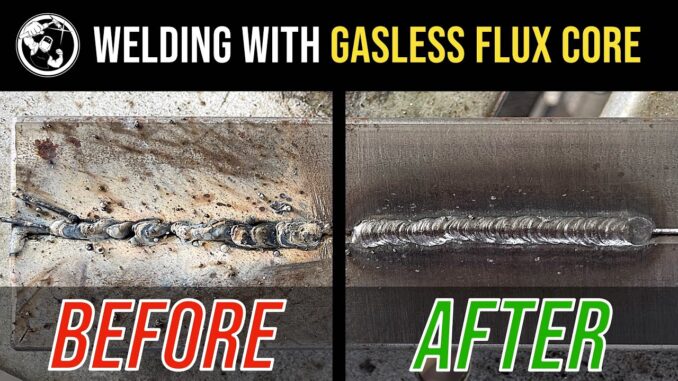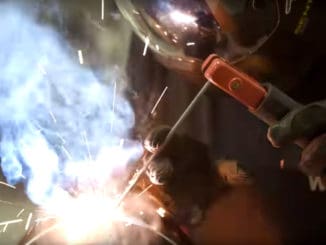
Setting up a self-shielded flux core welder correctly can make a world of difference in the quality of your welds. In this article and accompanying video, we’ll discuss the essential factors that can greatly impact your welding results. From understanding polarity to adjusting tension and stick-out, we’ll cover the key elements that contribute to successful welding with self-shielded flux core wire.
Setting Up the Welder
When setting up your self-shielded flux core welder, it’s crucial to pay attention to the following steps:
- Choosing the Right Wire: Select a self-shielded flux core wire suitable for your welding project. In this case, we’re using the NR211 wire by Lincoln, which is 0.35 inches in diameter.
- Preparing the Wire: Before starting, remove any rust or debris from the wire by stripping off several layers until you reach clean wire. Snip the wire and secure it in the spool’s hole to prevent it from unraveling.
- Adjusting the Drive Rollers: Use knurled drive rollers to provide a firm grip on the flux core wire without crushing it. Apply light tension and ensure there are no bends or burrs that could hinder smooth wire feeding.
- Installing the Contact Tip: Remove the contact tip to facilitate wire stripping and prevent any potential issues. Once the wire is pulled through the liner, reinstall the appropriate contact tip size and snug it down using MIG pliers.
- Nozzle Selection: While not necessary for flux core wire, you can use a flux core nozzle for improved visibility and protection against sparks. Regular MIG nozzles work too, depending on your preferences.
Understanding Polarity
For self-shielded flux core welding, it’s vital to set the correct polarity, which is direct current electrode negative (DCEN). Ensure that your welding machine is configured accordingly. Polarity information is often provided on the inside panel of the wire feeder cabinet.
Fine-tuning Welding Parameters
To optimize your welding experience, consider the following factors:
- Stick-Out Length: Stick-out refers to the distance between the contact tip and the welding puddle. For 0.35-inch self-shielded flux core wire, a stick-out of approximately 5/8 to 3/4 inch is recommended. Avoid using excessively long stick-outs to prevent wire wandering and poor weld quality.
- Gun Angle and Direction: Maintain a gun angle of around 45 degrees and a slight drag when welding. While there’s some flexibility, extreme angles can lead to increased spatter. Adjust the angle based on the specific welding requirements and limitations.
- Proper Grounding: Ensure your workpiece has a good ground connection, free from mill scale, paint, or grease. A stable ground is essential to maintain consistent wire feed speed and avoid welding issues.
- Personal Protective Equipment (PPE): Prioritize safety by wearing appropriate PPE, including gloves, a long-sleeved welding shirt, a high-quality helmet, safety glasses, and consider using a fan to redirect welding fumes.
Conclusion
By following these guidelines, you can significantly enhance the quality of your self-shielded flux core welds. Remember to check and adjust the polarity, use the correct stick-out length, and maintain a suitable gun angle. Take into account the manufacturer’s recommendations, stay mindful of wire tension, and ensure a solid ground connection. By paying attention to these details, you’ll achieve better results and improve your welding skills with self-shielded flux core wire.




